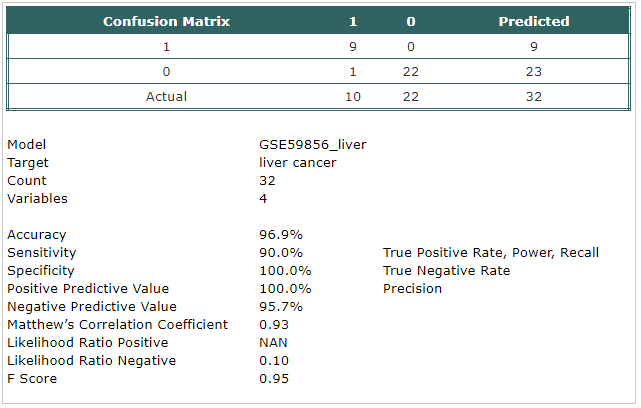GSE59856
|
| What
We Learned |
- It is difficult to detect pancreatic cancer or biliary-tract cancer at an early stage using current
diagnostic technology. Utilizing microRNA (miRNA) markers that are stably present in peripheral
blood, this study aimed to identify pancreatic and biliary-tract cancers in patients.
|
- 81 miRNAs for pancreatic cancer and 66 miRNAs for biliary-tract cancer showed statistically different
expression compared with healthy controls.
- Among those markers, 55 miRNAs were common
in both the pancreatic and biliary-tract cancer samples.
|
- A combination of eight miRNAs (miR-6075, miR-4294, miR-6880-5p, miR-6799-5p, miR-125a-3p, miR-4530,
miR-6836-3p, and miR-4476) achieved a sensitivity, specificity, accuracy and AUC of
80.3%, 97.6%, 91.6% and 0.953, respectively.
|
- Most pancreatic cancers do not accompany
any particular clinical symptoms in the early stage, permitting the cancers to progress undetected.
- In addition, ambiguous radiological images of cancerous lesions and inflammatory conditions
in the pancreas prevent pancreatic cancers from being correctly identified.
|
- The five-year survival rate for patients with exocrine pancreatic cancer is estimated at
14% for stage IA, but it drops to 1% for stage IV.
|
- Because the most promising treatment for pancreatic cancer is
surgical resection, detecting pancreatic cancer at surgically resectable stages is crucial for improving
the survival rate of patients with pancreatic cancer.
|
- The most validated and clinically useful biomarker is
carbohydrate antigen (CA) 19–9; however, CA19-9 is known to be up-regulated
in other inflammatory conditions, and its low positive predictive value makes it a poor biomarker
for screening, limiting its current use mostly to the post-surgical monitoring of progressed
pancreatic cancers.
|
- The discrepancies of previous studies could be attributed to:
- Various empirical factors that include the blood sample types (PBMC, plasma or
serum)
- Different detection technologies
(PCR, microarray or sequencer)
- Heterogeneity of the sample
cohorts
- The sufficient size and the diversity
of the sample cohorts are critical in biomarker research not only for the targeted group but also for the control group.
|
- This study examined the expression profiles of comprehensive serum miRNAs from the largest
cohorts of patients:
- pancreatic cancer 100
- colon cancer 50
- biliary tract cancer 98
- esophagus cancer 50
- liver cancer 52
- healthy control 150
- stomach cancer 50
- benign pancreatic or biliary tract diseases 21
|
|
| What
We Did |
- A classification model has been built using Trainset.
The selected probes were:
- hsa-mir-6849-5p
- hsa-mir-204-3p
- hsa-mir-663b
- hsa-mir-106a-5p
|
- The model has been tested using Testset.
|
 |
|

